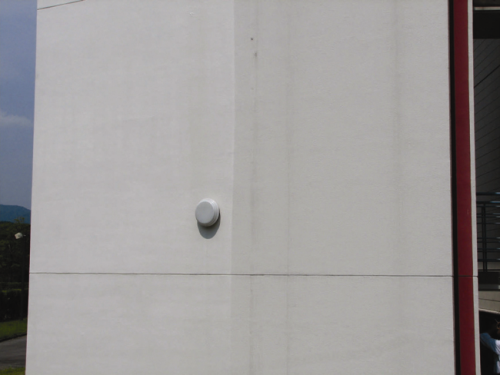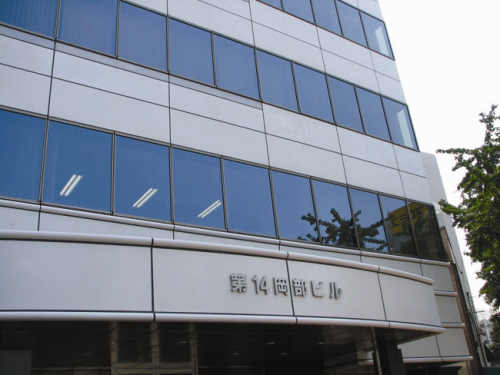

All of these benefits are based on two separate properties discovered in a particular form, after unique processing, of the mineral titanium dioxide, or TiO2. When the most prevalent form of TiO2 ,rutile, is converted via extremely high temperatures to the anatase form, and subsequently processed to a suspension of nano-sized particles, these properties are created.
The beneficial actions of such a coating are twofold. The first is the result of the formation of extremely strong oxidizers at or within the surface of the coating when in the presence of any UV light source. The second is the creation of a “water-loving” surface with what has been termed “super-hydrophilicity” when water comes into contact with the coated surface. This hydrophilic characteristic creates a thin film of water on the coated surface, which allows contaminants on the coated surface to be easily washed away. The presence of UV light energy is also necessary for the development of super-hydrophilicity.
THE DISCOVERY
In the 1960s, a graduate student at the University of Tokyo, Dr. Fujishima Akira, discovered some minor photocatalytic oxidation activity in zinc oxide under the radiation of UV light energy. This led to the study of numerous metal oxides to discover the one that measured best at catalyzing the reaction of light energy in UV to cause the splitting of water (vapor) present in the ambient air in contact with the metal oxide catalyst. In 1967, Akira discovered the rutile form of TiO2 had some photo activity, but the anatase form was far and away the most efficient at catalyzing this reaction. The rutile form of TiO2is the most prevalent in nature and is widely used as the white pigment in paint. The anatase form is the second-most prevalent in nature and can be formed from the rutile form using extremely high temperatures. A third and much more rare form (brookite) also exists.
INTELLECTUAL PROPERTY
The incorporation of this technology into a system allowing the coating of the wide variety of surfaces necessary to take advantage of these unique properties required much more research and innovation. First, it was necessary to develop something with the required adhesion properties. Next was the tricky matter of keeping the coating from oxidizing and damaging the very surface on which it was applied and intended to protect. More than 3,000 patents currently exist relative to the photocatalytic activity of TiO2, mostly in Japan. Most involve a dry process whereby the anatase form is brought down to nano-sized particles. The problem is achieving an adequate dispersion to allow for applications such as coatings, as agglomeration of the TiO2 particles is apt to occur.
About 10 years ago another Japanese researcher and associate of Dr. Fujishima Akira, Dr. Ichinose, resolved this problem by developing and patenting a wet process that achieves a yellowish solution with even smaller particle sizes and, more importantly, without the agglomeration phenomenon that complicates most coating applications attempted using the dry process.
Tioxoclean Inc., a U.S. company, working under a cross-licensing agreement with the Japanese, further improved on the wet process. The resulting improved wet process offers four advantages: The slight yellow color issue seen with the earlier liquid process products does not exist. Due to the smaller particle size and resulting greater surface area, photo activity is even higher. Use of a wetting agent improves coating performance, especially for glass substrates. Lastly, the overall “wet” process is less expensive. The resulting coating technology also involves the use of the less active rutile form of TiO2to protect organic substrates from oxidation-based damage. This product is labeled “OxiShield.” Then (or in the case of inorganic substrates, directly) the active form of the TiO2 coating is applied. The photo active product is labeled “OxiGuard.”
HOW DOES IT ADHERE?
The suspension of nanoparticles, upon drying, leads to the deposition of a very thin layer of the TiO2 This thin amorphous mineral film deposition is extremely difficult to remove, as the bonding mechanism is essentially electrochemical. Its adhesion has been measured at 4B to 5B (4B = less than 5% is removed after aggressive removal efforts; 5B = none is removed). It is resistant to damage from most acids, bases, and physical abrasion. In fact, only the use of an strong ammonia solution and strong physical abrasion has been shown to damage or remove it.
The hardness of this coating has been measured as a 5H after 24 hours, progressing to a 7H after one week. Note: Some applications of this coating technology in Japan applied to a variety of both interior and exterior surfaces nearly five years ago still demonstrate adequate photo activity, and are still yielding the aforementioned beneficial properties.
HOW IT WORKS, and WHY IT’S SAFE
Once the film has been properly applied and cured (note: reaching a full cure and maximum hardness can take a week) and in the presence of the minimum level of sufficient UV light energy, the active form of TiO2creates positive and negative cells that, in the presence of oxygen and water vapor, split the water and form the very strong oxidizing agents hydroxyl and oxygen radicals. Anything oxidizable that is also in contact with the coating, particularly if adsorbed on the coating, will be oxidized. As this reaction continues, even fairly complex organic or inorganic species will continue to be oxidized to their simplest form, such as carbon dioxide, sulfur dioxide, nitrogen dioxide, etc.
The TiO2 meets the truest definition of a catalyst during this process, as it remains unchanged and unaffected while this oxidant-producing reaction progresses. The oxidizing species created by this process are some of the strongest known to man, but they exist only for nanoseconds and only at, and within, the very surface of the TiO2 film where they are produced, where upon they will encounter something oxidizable and immediately react. The self-cleaning and bio-film removing properties of this surface eventuate as the oxidized species leave as gasses, or reach a point where dislodging them with a simple wash is easily effected, making use of the super-hydrophilicity property described next. In less technical terms, the coating in the presence of some level of UV light energy is self cleaning.
SUPER-HYDROPHiLICITY
This is the description given to the phenomena shown by water on surfaces coated with the “activated” photocatalytic TiO2film. Water tends to bead when it encounters most surfaces. This beading is a combination of the surface tension of the water itself and the relative polarity of the water versus the polarity of the surface with which it is in contact. Surfactants are added to water to change this surface tension—the basic chemistry of soap. A wetting agent is commonly added to a water-based solution (coatings, cleaners, etc.) to decrease the beading phenomena, and allow sheeting or more complete wetting of the surface.
A manner of quantifying this phenomenon is to measure the angle created by the water droplet to the surface it contacts. Imagine water droplets on a freshly washed and waxed car hood. The angle created by the water droplet and the surface will be fairly large, sometimes approaching 90°. If this surface is treated with the photocatalytic TiO2film, the angle does not initially change. However, once the surface has received some UV light energy and becomes activated, the angle changes rapidly and approaches zero, and the water does not form a droplet but rather sheets, or forms a very thin film, and runs off.
This phenomenon enhances the self-cleaning nature of the surface and leads to some interesting fog-, frost-, and mist-proof properties. It also emphasizes the importance of making sure any surface treated with the photo catalytic TiO2film is “water sealed,” or it will endeavor to take on water. For surfaces where this is of concern, the use of the rutile form of the TiO2 coating system (the primer) will provide this necessary function, along with protecting the surface from being damaged by the oxidizing nature of the anatase or more photocatalytically active form of the coating. The surface will remain activated in the absence of any UV light energy for 2 to 5 hours, depending on the surface, amount of activation, etc.
BIO-FILM REMOVAL
This capability of the photocatalytic TiO2coating offers wide market appeal. Imagine all the surfaces that must be kept clean, disinfected, sterile, and antiseptic, etc., and the extensive use of cleaning and pesticide-based sanitizing agents necessary to achieve these levels of cleanliness. Once a surface is properly coated with the photocatalytic TiO2coating, and exposed to UV light energy, testing has shown a high level of efficacy is achieved in oxidizing and preventing the creation of a wide variety of bio-films. Some specific testing on Eschericia coli, or E. coli, Staphylococcus aureus, staph, SARS, and MS2 coliphage showed definitive efficacy at removal via oxidation of each of these species, with some reductions approaching 100% in just an hour. These tests were conducted using various indoor lighting sources, as well as natural sunlight.
To better appreciate and quantify this bio-film removal phenomenon, SAFE Encasement Systems-Midwest provided an industrial hygiene testing and consulting firm, BEM, with samples of the TiO2photo-active coating. BEM used spoiled 1% milk as the common contaminate on three different surfaces: ceramic tile, sheet metal, and plastic. BEM used their “Bio-Reveal” ATP bioluminescence testing technologies for the determination of the biological activity of the contaminated surfaces in a 15-second per analysis turn around. In summary, the contamination levels over the TiO2 photo-activated surfaces showed reductions in contamination of 80–90%, whereas the contamination levels over non-treated surfaces showed gains in contamination from 280 to 2,080%. Details on this testing and the test report can be found on the BEM products website, www.bio-reveal.com.
ODOR REDUCTION
Another fascinating aspect of a TiO2-coated surface receiving some level of UV light energy is its ability to remove odors from the immediate environment. Numerous examples already exist where the uses of TiO2 photocatalytic coatings have been applied and the occupants notice a marked improvement in odor levels. With odor being such a subjective parameter, I think the following test method and its results better quantify this application for our understanding. A 5-liter bag is charged with air and 80–100 ppm acetaldehyde. A GC, or gas chromatograph, is used for determining the actual acetaldehyde level. Also placed into the bag is a surface coated with the TiO2photo-active coating. Duplicate bags set up as such are then exposed to conditions with no light and conditions with a known UV light energy source for 2 hours. GC analyses are run on the air samples and a percent loss in acetaldehyde levels determined. Virtually no changes were detected in acetaldehyde levels in the bag with no light energy, whereas the bag with a UV light energy source demonstrated 80–90% losses in acetaldehyde levels over a 2-hour time frame.
BIO
Fred Budde is a chemical engineer with nearly 30 years of experience in manufacturing, R&D, sales, and marketing. He has worked in the area of coatings, first as a supplier of chemical intermediates, then in development, marketing, and sales. Budde also performs forensic investigations. He can be reached at febudde@msn.com.




